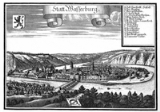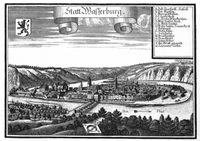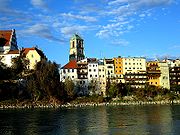
Wasserburg am Inn
Encyclopedia
Wasserburg am Inn is a town in the district Rosenheim
in Upper Bavaria
, Germany
. The historic centre is a peninsula, formed by the meandering Inn River
. A lot of buildings survived from medieval times giving the city a unique air.
 The town was first mentioned in a document (now considered to be a fake) in 1137, when Hallgraf Engelbert moved his residence from the nearby castle Limburg to his "Wasserburg" (Water Castle).
The town was first mentioned in a document (now considered to be a fake) in 1137, when Hallgraf Engelbert moved his residence from the nearby castle Limburg to his "Wasserburg" (Water Castle).
It is one of the most historic towns of Old Bavaria – somewhat older than Munich, continually fought over by the Bavarian nobility and, up to the 16th century, on an equal footing with larger cities. The privileges afforded by this enabled the salt trade to flourish right into the 19th century. At the junction of the main overland route with the main water route, Wasserburg became the most important trade centre with the Balkans, Austria and Italy, a means of attaining power and wealth for the shipping owners and merchants.
In the early days, Wasserburg was an important hub in the salt trade. Its bridge was the only possibility to cross the river Inn for 30 km in both directions. On its shore the salt, mined in Berchtesgaden
or produced in the Saline (saltern) at Bad Reichenhall
and shipped from there by cart, could be loaded on ships travelling on the Inn River. Up to the 17th century Wasserburg was used as the port of the capital Munich
.
Up until 1972, when it was merged with the district Rosenheim, Wasserburg was a district capital on its own.
 The population of Wasserburg is approx. 12,000.
The population of Wasserburg is approx. 12,000.
Rosenheim (district)
Rosenheim is a Kreis in the south of Bavaria, Germany.Neighboring districts are, clockwise from the west, Miesbach, Munich, Ebersberg, Mühldorf, and Traunstein, with the Austrian province Tirol across the southern border....
in Upper Bavaria
Upper Bavaria
Upper Bavaria is one of the seven administrative regions of Bavaria, Germany.- Geography :Upper Bavaria is located in the southern portion of Bavaria, and is centered around the city of Munich. It is subdivided into four regions : Ingolstadt, Munich, Bayerisches Oberland , and Südostoberbayern...
, Germany
Germany
Germany , officially the Federal Republic of Germany , is a federal parliamentary republic in Europe. The country consists of 16 states while the capital and largest city is Berlin. Germany covers an area of 357,021 km2 and has a largely temperate seasonal climate...
. The historic centre is a peninsula, formed by the meandering Inn River
Inn River
The Inn is a river in Switzerland, Austria and Germany. It is a right tributary of the Danube and is approximately 500km long. The highest point of its drainage basin is the summit of Piz Bernina, at 4,049 metres.- Geography :...
. A lot of buildings survived from medieval times giving the city a unique air.
History

It is one of the most historic towns of Old Bavaria – somewhat older than Munich, continually fought over by the Bavarian nobility and, up to the 16th century, on an equal footing with larger cities. The privileges afforded by this enabled the salt trade to flourish right into the 19th century. At the junction of the main overland route with the main water route, Wasserburg became the most important trade centre with the Balkans, Austria and Italy, a means of attaining power and wealth for the shipping owners and merchants.
In the early days, Wasserburg was an important hub in the salt trade. Its bridge was the only possibility to cross the river Inn for 30 km in both directions. On its shore the salt, mined in Berchtesgaden
Berchtesgaden
Berchtesgaden is a municipality in the German Bavarian Alps. It is located in the south district of Berchtesgadener Land in Bavaria, near the border with Austria, some 30 km south of Salzburg and 180 km southeast of Munich...
or produced in the Saline (saltern) at Bad Reichenhall
Bad Reichenhall
Bad Reichenhall is a spa town, and administrative center of the Berchtesgadener Land district in Upper Bavaria, Germany. It is located near Salzburg in a basin encircled by the Chiemgauer Alps ....
and shipped from there by cart, could be loaded on ships travelling on the Inn River. Up to the 17th century Wasserburg was used as the port of the capital Munich
Munich
Munich The city's motto is "" . Before 2006, it was "Weltstadt mit Herz" . Its native name, , is derived from the Old High German Munichen, meaning "by the monks' place". The city's name derives from the monks of the Benedictine order who founded the city; hence the monk depicted on the city's coat...
.
Up until 1972, when it was merged with the district Rosenheim, Wasserburg was a district capital on its own.
Demography


